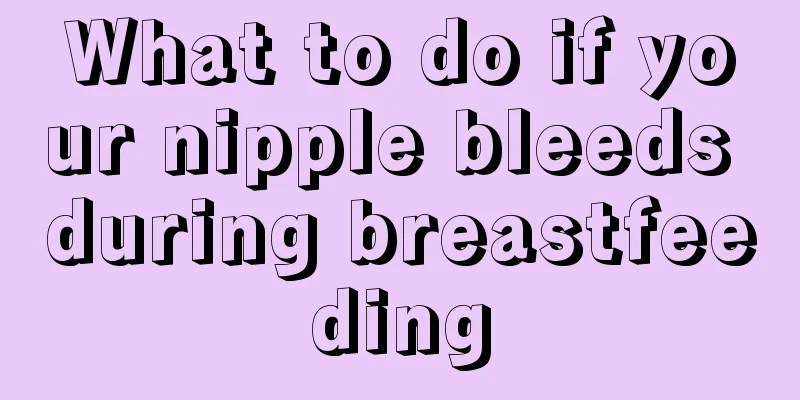What to do if your nipple bleeds during breastfeeding

|
Sometimes, mothers find that their nipples are bleeding when they are feeding their babies or during breastfeeding. This situation will make mothers panic. In fact, mothers should not worry too much. Generally, nipple bleeding is actually nipple cracking. So what should we do in this case? When the nipples are cracked, apply hot and wet compresses before each feeding, massage the breasts to stimulate the milk ejection reflex, and then squeeze out a little milk to soften the areola, making it easier for the nipple to connect with the baby's mouth. When feeding, suck the healthy breast first. If both breasts are cracked, suck the less severe side first. Make sure the baby holds the nipple and most of the areola in his mouth, and change feeding positions frequently to reduce stimulation to the nipple when sucking hard. After feeding, press the baby's lower jaw lightly with your index finger, and when the baby opens his mouth, take the opportunity to pull out the nipple. Do not pull the nipple out of the baby's mouth abruptly. After each breastfeeding, squeeze out a little milk and apply it on the nipples and areola to keep the nipples dry. At the same time, the protein in the milk promotes the repair of damaged nipples. Causes of Nipple Cracks The nipple skin of a new mother is relatively delicate and cannot withstand the stimulation of the baby's sucking, especially when there is insufficient milk or the nipples are too small or inverted. As the baby sucks and bites the nipples hard, the nipple epidermis is soaked in saliva and becomes softened, peeled off, and eroded, forming cracks of varying sizes. In addition, the baby's sucking posture is incorrect, and the nipple and most of the areola are not covered, or the nurse excessively cleans the nipple with soap, alcohol and other irritants, causing the nipple to become too dry, which can easily cause the nipple skin to crack. In severe cases, the nipple may become ulcerated and lead to secondary infection. Usually, the yellow liquid that seeps out of the crack will form a scab after drying, which is dry and painful. Especially when the baby is feeding, it will feel like a knife cutting and is unbearable. Once bacteria enter through the crack, they will invade the breast and cause mastitis or breast abscess, necessitating the interruption of breastfeeding. After reading the above content, I believe that mothers have a certain understanding of their nipple bleeding. If some mothers are still worried about their situation, it is recommended to go to the hospital for examination, determine the cause and then take targeted measures. However, for the sake of the child, the mother should not breastfeed the child during the period of nipple bleeding. Wait until the situation is completely healed before breastfeeding. |
<<: How to protect private health
>>: What to do if your breasts hurt during lactation
Recommend
Can touching your vagina cause infection?
Frequently touching the genitals will increase th...
An 81-year-old man from Guangdong was forced to have his finger amputated after getting infected after pricking it while washing shrimp
recent, Mr. Mo, 81 years old, from Dongguan, Guan...
What should I do if the leaves of Clivia turn yellow? What should I do if the roots of Clivia rot?
Clivia miniata (scientific name: Clivia miniata),...
What is breast clamp test?
Mammography, full name mammography X-ray examinat...
What is the follicular phase?
The follicle has a certain follicular phase, whic...
Will my breasts swell and ache during ovulation?
Breast tenderness may occur during the ovulation ...
Ultrasound of gestational sac at 5 weeks of pregnancy
Generally, women will not realize they are pregna...
Female private parts body odor
It is abnormal for female friends to notice body ...
Is high-risk HPV positive 56 serious?
There are many types of high-risk HPV infection, ...
Do I need to have a uterine curettage after the gestational sac is expelled?
After the gestational sac is expelled after medic...
The harm of cold water washing hair for girls
For girls, you must use warm water to wash your h...
Is the temperature high all day after pregnancy?
Human body temperature is very easy to change wit...
Reasons for decreased fetal movement after getting angry
Having a baby is an exciting thing. However, the ...
Know the stock market in advance
Author: Xiao He, attending physician at Nanfang H...









